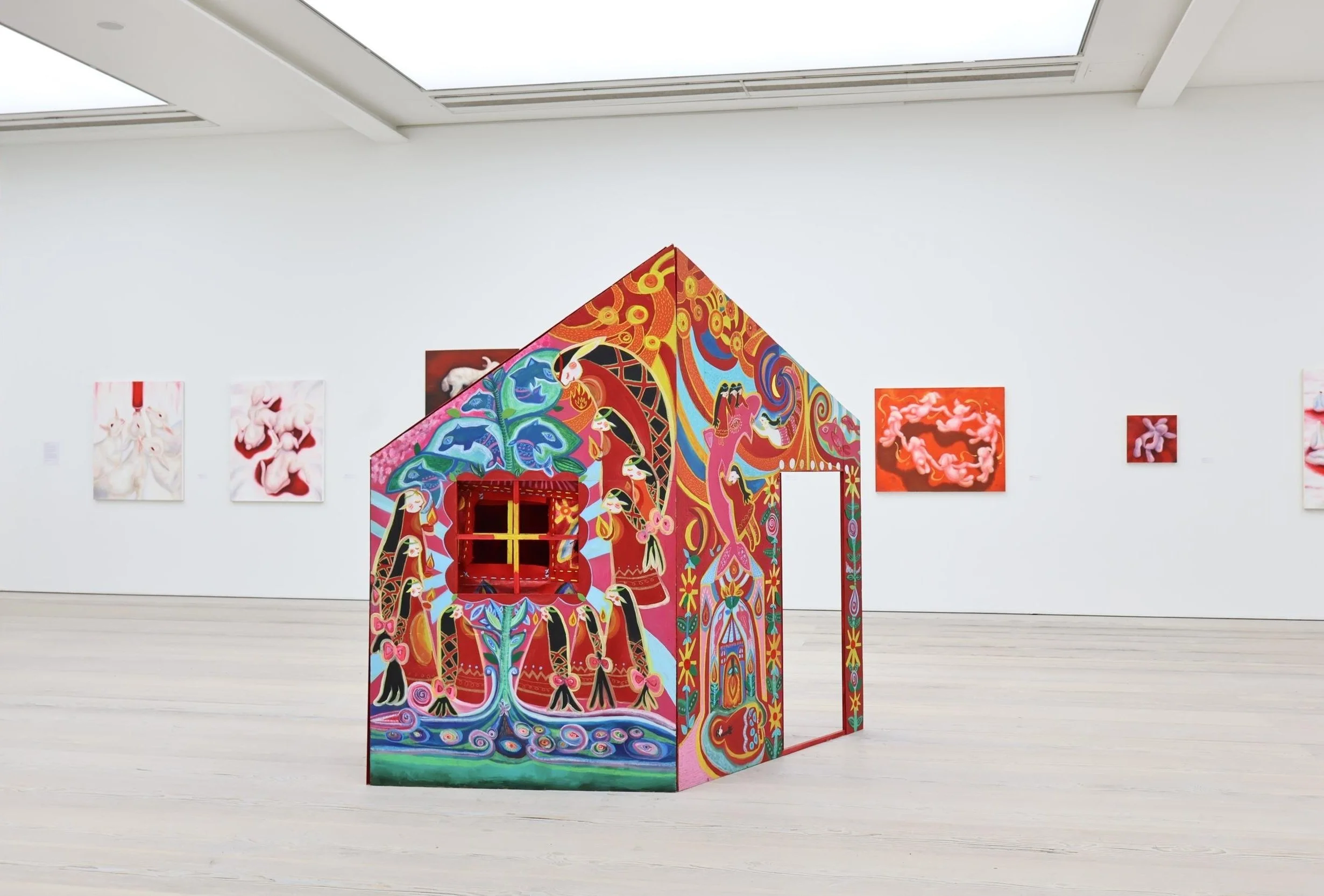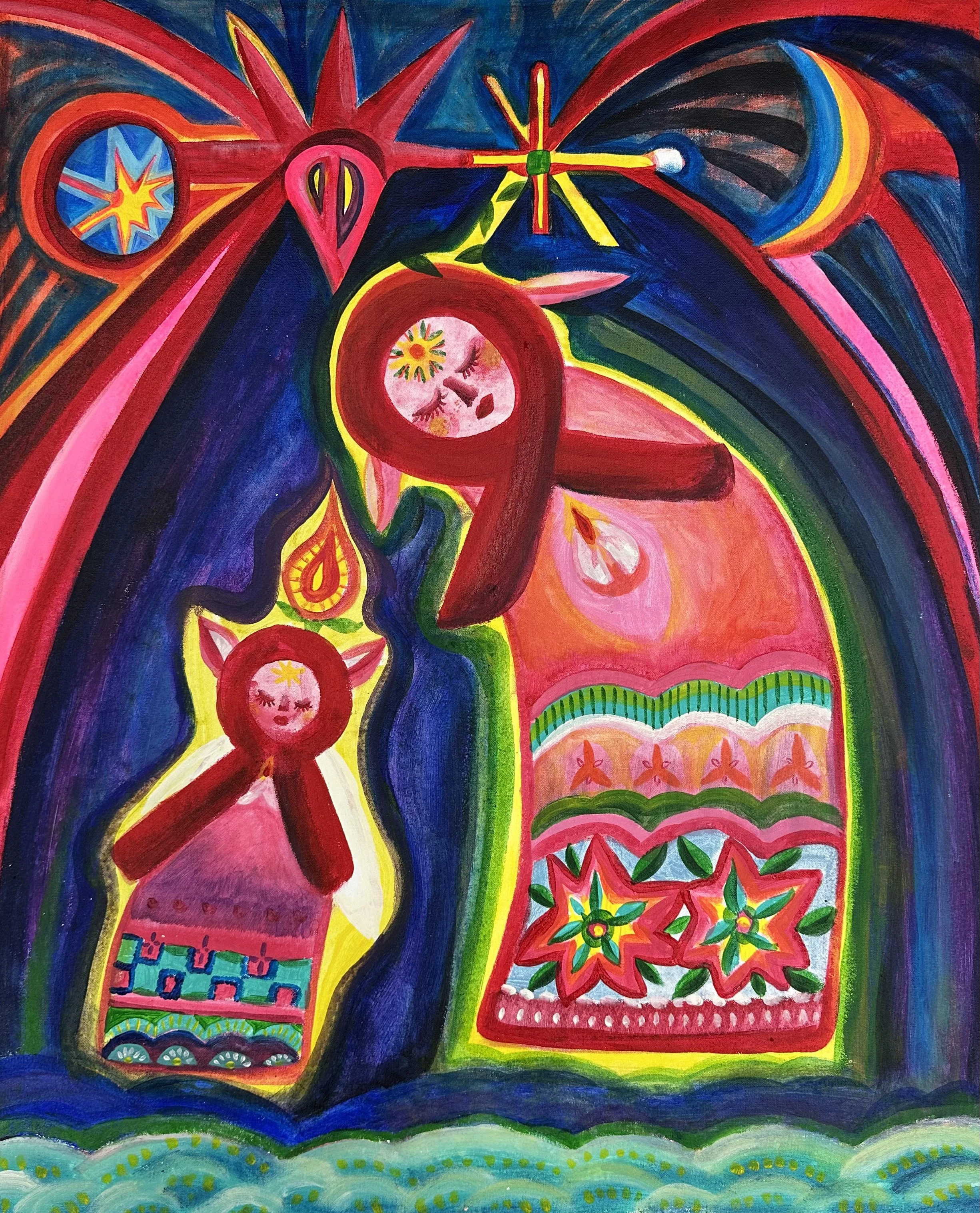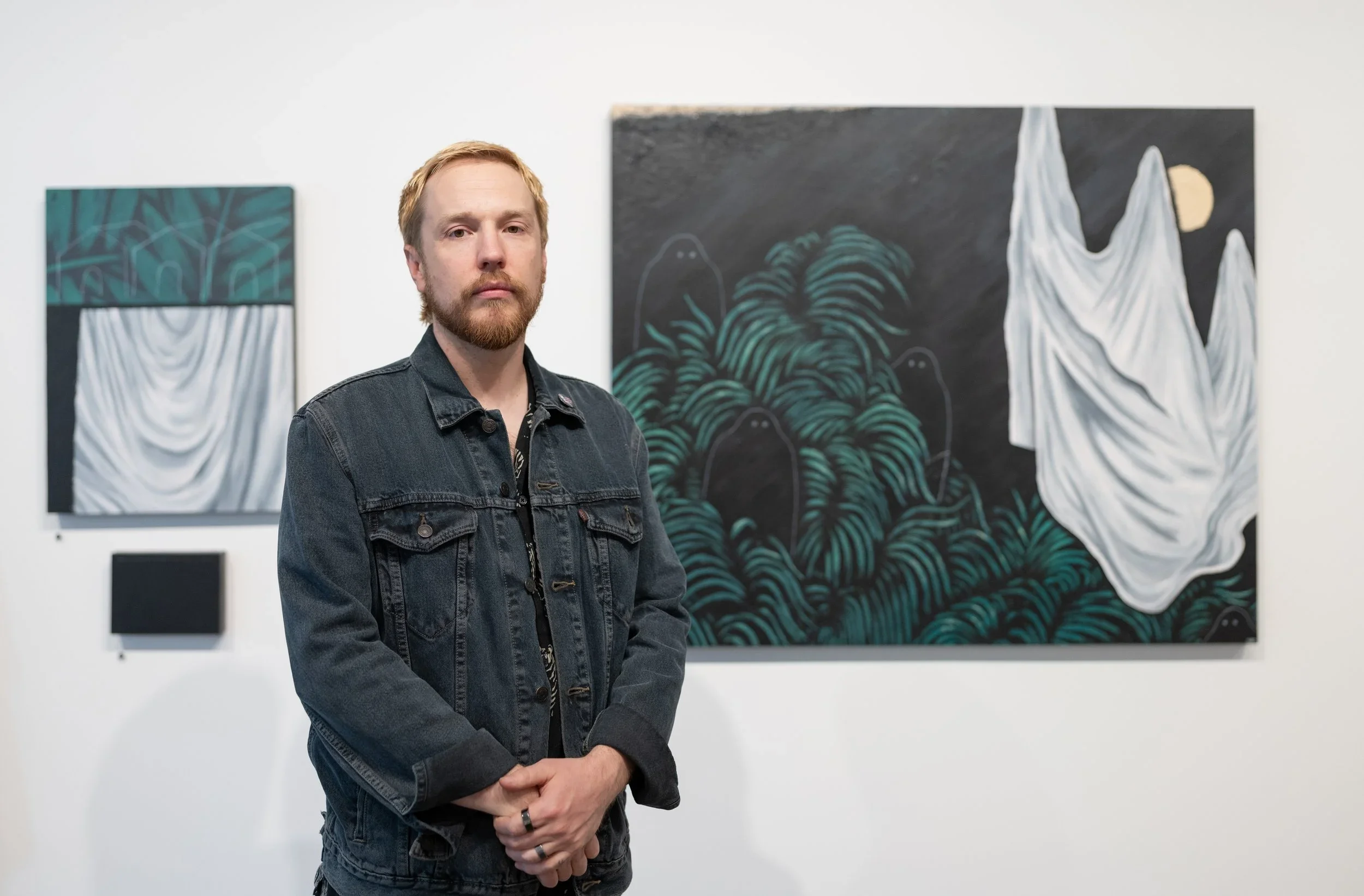10 Questions with Hsin Hwang
Hsin Hwang is a Taiwanese visual artist whose practice encompasses painting, drawing, printmaking, textiles, and installation art. She holds a Master's degree from the Royal College of Art (RCA) in London. Deeply influenced by fairy tales, mysticism, and Jungian psychology, her work draws from dream imagery, faith, and personal experiences to depict inner spiritual landscapes. Through vibrant colours and symbolic elements, she explores complex spiritual themes with a playful and childlike visual language. By integrating belief systems from diverse cultures, Hwang articulates a personal yet universal quest for faith and spirituality. Her work serves not only as a process of self-inquiry but also as a healing force, offering resonance and care.
In 2023, Hwang joined a Jungian reading group in London, where she studied concepts such as the collective unconscious, shadow, anima/animus, and archetypes. These psychological frameworks have become integral to her practice, inspiring a series of works that explore love, loss, trauma, healing, and spiritual transformation. In 2025, her graduate work was selected for the Narratives of Identity exhibition at the Saatchi Gallery in London. Her work has been collected by the Royal College of Art and private collectors.
Hsin Hwang - Portrait
ARTIST STATEMENT
Hsin Hwang's artistic practice explores mythology, faith, and the subconscious, weaving narratives that transcend cultural and geographical boundaries. Through painting, printmaking, textiles, and installation, she examines the intersections of personal spirituality and collective belief systems. Influenced by fairy tales, mysticism, and Jungian psychology, she employs dream imagery and symbolic elements to portray inner spiritual landscapes. With vibrant colours and a childlike visual language, her work reflects themes of transformation, devotion, and resilience, often centring on the evolving roles of women in myth and belief.
In recent years, Hwang's work has become increasingly rooted in cross-cultural exchange and the narratives of the Global South. She immerses herself in diverse cultural contexts, researching folklore, myths, and spiritual traditions. Her approach reinterprets Taiwan's indigenous and folk narratives alongside global symbols of nature and femininity. Through this process, she seeks to create a visual language that bridges cultural traditions, illuminating universal motifs of female transformation, ancestral wisdom, and nature worship, while exploring their shifting meanings across societies.
By reweaving myths across time and place, Hwang aims to reveal both shared resonances and distinct cultural identities within the collective unconscious. At the same time, she remains committed to reimagining Taiwan's indigenous and folk traditions through a contemporary lens, emphasising their ongoing relevance and fluidity in the modern world.
A red love letter to my home on a hill in Taiwan, Mixed media, 280x210x120 cm, 2024 © Saatchi Gallery - Hsin Hwang
INTERVIEW
Let's first introduce yourself to our readers. Who are you, and how did you develop into the artist you are today?
My name is Hsin Hwang. I’m a Taiwanese visual artist working across painting, printmaking, textiles, and installation. I often say that I grew up with gods and stories, surrounded by Taiwanese folklore, temple festivals, and the rituals of everyday magic. Later, while studying in London, I began to explore European fairy tales and mythologies in greater depth. I became fascinated by the way different cultures use similar archetypes—such as the witch, the wolf, or the wandering spirit—to explore inner transformation, fear, and desire. My artistic journey has since evolved into a cross-cultural dialogue between Eastern animism and Western myth, between personal memory and collective story.
You work across painting, drawing, printmaking, textiles, and installation. What draws you to working in so many mediums, and how do you decide which to use for a particular idea?
Painting is my first love—it’s where I feel most instinctive and alive. But over time, I realised that painting alone couldn’t fully contain the world I wanted to build. During my university years, I studied fashion design, which opened me to the tactile world of textiles and the body. That experience planted a seed in me: the desire to break out of the flat surface and build something more spatial, more immersive. I love experimenting with different materials—combining softness with structure, image with object—so that ideas can grow beyond two dimensions. Each project starts with a feeling or a vision, and the medium reveals itself as the work evolves.
When you hear my prayer, I am able to find the way home, 100x162 cm, 2024 © Hsin Hwang
Your art often feels dreamlike and symbolic. How have fairy tales, mysticism, and Jungian psychology shaped your visual language?
I often draw from the core of the feminine hero’s journey hidden within fairy tales. These stories, beneath their simplicity, carry profound psychological truths. Fairy tales taught me that narrative is a vessel for transformation; mysticism taught me to believe in the unseen and to work with symbols as bridges between worlds. Sometimes I reference magical motifs found in semiotics and occult literature—sigils, talismans, or mythic creatures—and incorporate them into my own visual system. Jungian psychology gave me a deeper language to recognise the archetypes that dwell within me, allowing me to explore the shadow, the anima, and the inner child with more clarity.
What first sparked your interest in Jungian thought, and how has your experience in the London reading group influenced your recent work?
It began with a quiet yearning to understand myself through symbols. I joined a Jungian reading group in London, and The Red Book felt like finding a mirror. We discussed shadow, animus, and the collective unconscious—it gave me a vocabulary for the inner mythologies I had been painting all along.
Themes like love, loss, trauma, and healing recur in your practice. How do you use visual symbols to explore deeply emotional and spiritual ideas?
I often paint figures in a state of prayer—women who are quietly yearning for light, healing, or hope. They are not alone: by their side are small animals, protective spirits, or celestial beings like the moon, sun, or stars. These symbols act as guardians, guiding them through darkness. Through this visual language, I try to depict the unseen forces that surround us in moments of vulnerability—offering not answers, but a sense of presence, connection, and quiet strength.
When I embrace your faith, I will be illuminated, acrylic on canvas, 72x84 cm, 2023 © Hsin Hwang
When void is like the stars outside the window,I hear the sound of your sigh, Acrylic, 66x72 cm, 2024 © Hsin Hwang
Candle, apple, tears passing through the night passing through me, Acrylic, oil pastel, embroidery thread on canvas, 66x72 cm, 2024 © Hsin Hwang
Your palette is often vibrant and playful, even when dealing with heavy topics. How do you balance childlike visuals with complex inner worlds?
Colour, for me, is an intuitive language—it moves faster than thought. I often work instinctively with bright hues, using childlike imagery to soften or veil the emotional weight beneath. But in some of my recent series, I’ve limited myself to just black and red, or a single hue like crimson or ultramarine. These works quietly trace themes of trauma, grief, and the disappearance of life, not only as emotional expressions, but also as spiritual reflections. They ask: where does the soul go? I rarely depict sorrow in a literal way. Instead, I use colour to suggest an inner atmosphere, a psychological temperature. Even when dealing with loss, I try to hold space for tenderness and sometimes even joy. The childlike tone isn’t meant to escape pain, but to stay with it gently.
You incorporate belief systems from different cultures. Can you discuss your approach to spirituality in your work, and how you navigate between the personal and the universal?
I see spirituality as a shared longing, expressed through different myths, rituals, and symbols. In my work, I often blend animistic beliefs from Taiwan with Jungian archetypes or European fairy tales.
You've described your work as a form of healing. What does that process look like for you, both as an artist and as a person?
For me, healing is a slow and gentle process of returning to wholeness. Whenever I paint or weave, I feel very calm. When I am fully immersed in creation, I can feel a kind of energy that I can’t quite describe—it feels like unconditional love, a sense of inner peace.
Celestial stone babe, lithography, 70x100 cm, 2023 © Hsin Hwang
When I sleep, the little candles sing the song of the sun, lithography, 29x40 cm, 2023 © Hsin Hwang
Does your Taiwanese background and your time in London influence your perspective on identity and spiritual transformation?
Absolutely. Growing up in Taiwan taught me how to see spirits in everyday life—to sense the sacred in the ordinary, through rituals, festivals, and ancestral beliefs. In London, through my time in a Jungian reading group, I learned how to name the unseen forces within me—the archetypes, the shadows, the unspoken longings. Living between these two cultural worlds has made me especially sensitive to in-between states: tradition and modernity, East and West, the visible and the invisible. This tension is not a conflict, but a fertile space where transformation begins, both spiritual and artistic.
Lastly, what themes or materials are you excited to explore next? Are there any upcoming projects we should look out for?
Lately, I’ve been drawn to travelling and collecting cultural narratives across different regions, weaving them into my own visual language. This year marks a journey through Asia—I’m currently in Foshan, China, for a residency, where I’ve become fascinated by the local lion dance tradition and its symbolic power. In July, I’ll head to Busan, South Korea, for a three-month residency to explore coastal mythology and oceanic folklore. In November, I’ll return to southern Taiwan, to Tainan, where I’ll study the works and hometown of a Taiwanese outsider artist whose raw creativity deeply resonates with me.
Artist’s Talk
Al-Tiba9 Interviews is a promotional platform for artists to articulate their vision and engage them with our diverse readership through a published art dialogue. The artists are interviewed by Mohamed Benhadj, the founder & curator of Al-Tiba9, to highlight their artistic careers and introduce them to the international contemporary art scene across our vast network of museums, galleries, art professionals, art dealers, collectors, and art lovers across the globe.























